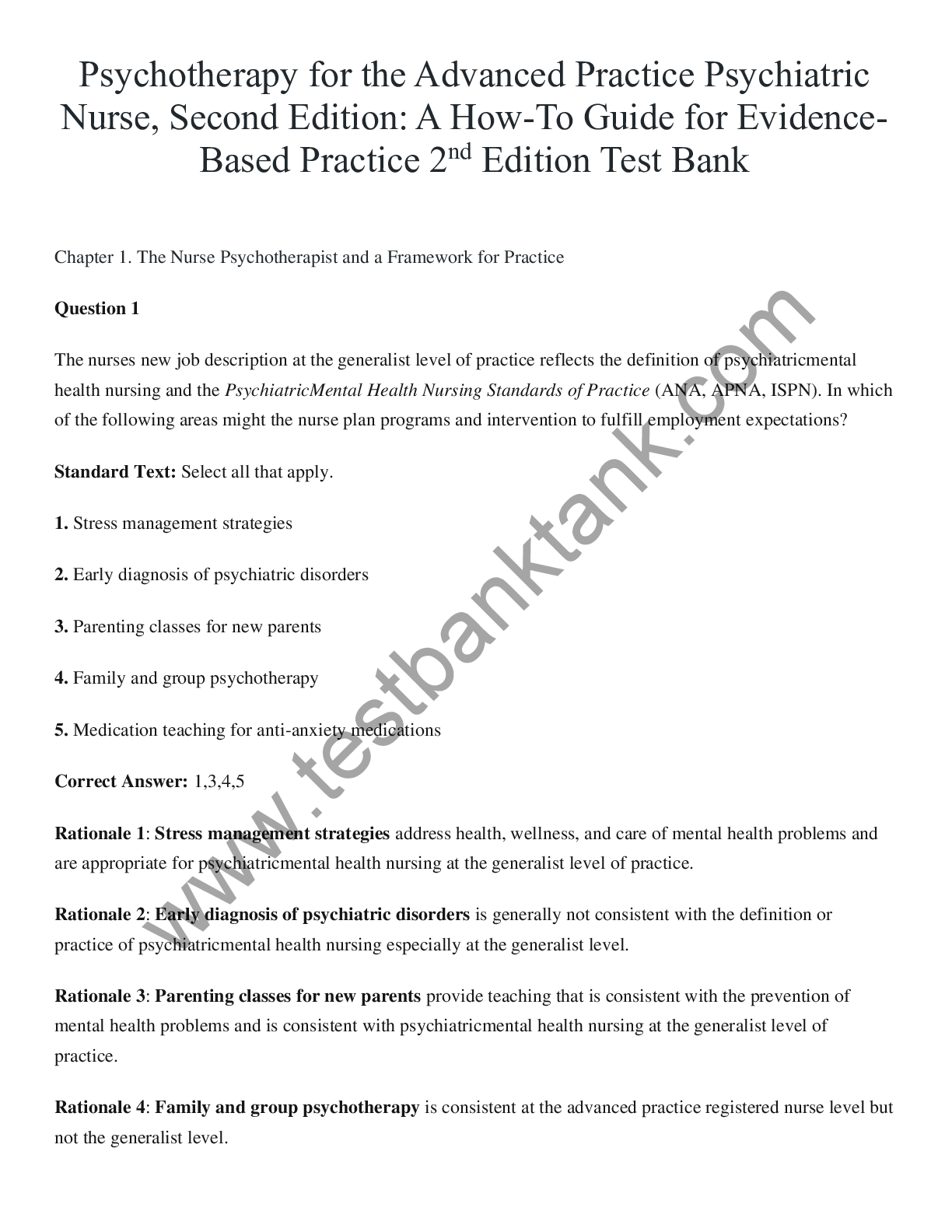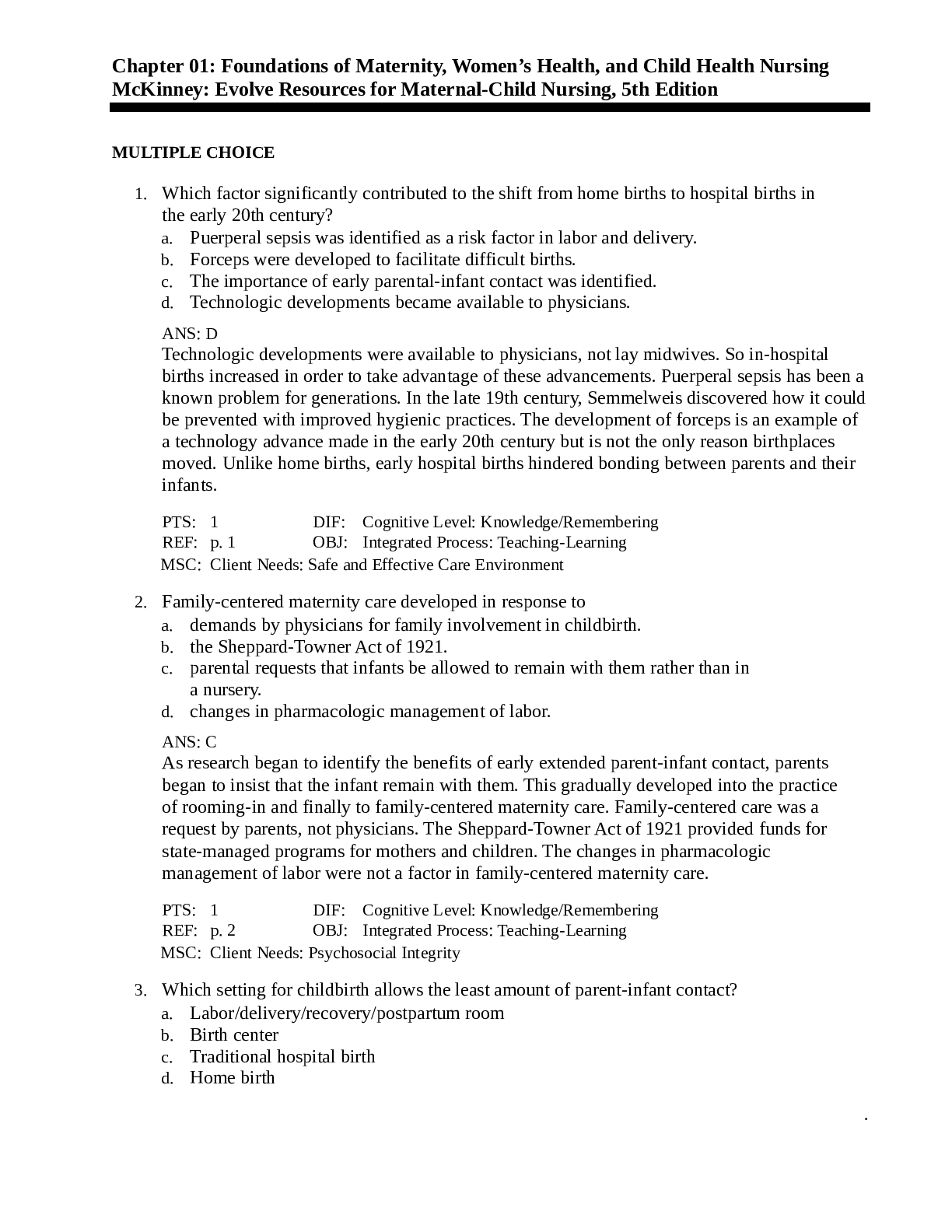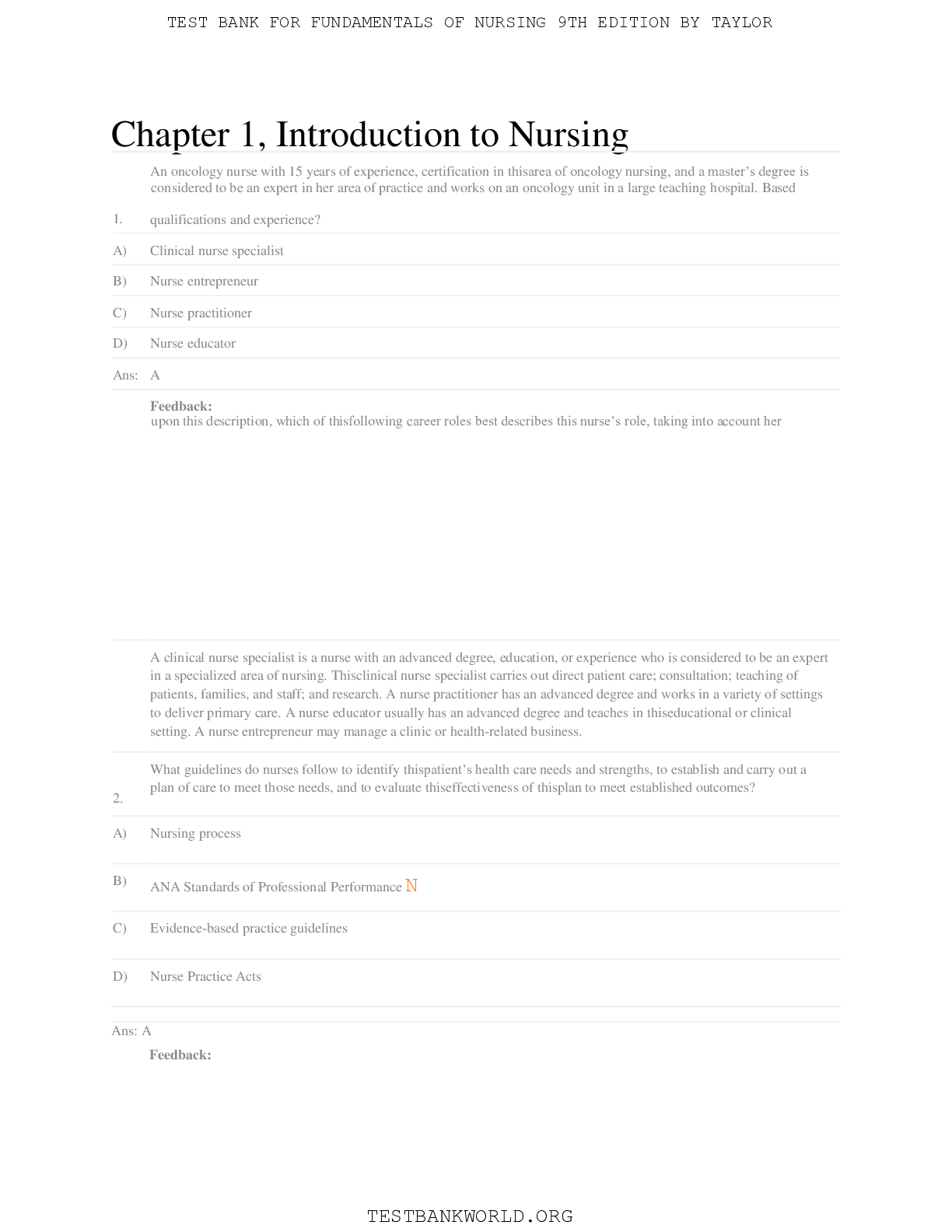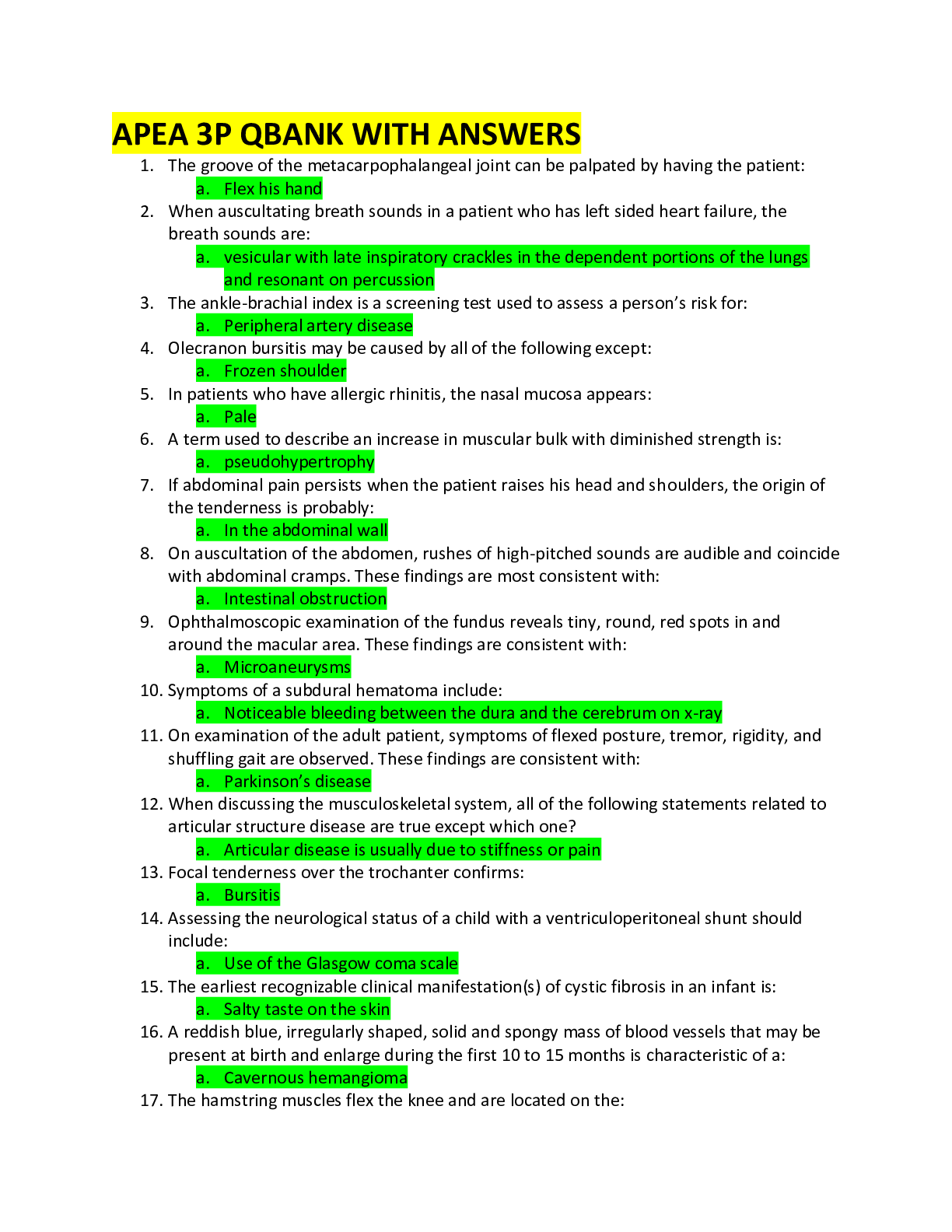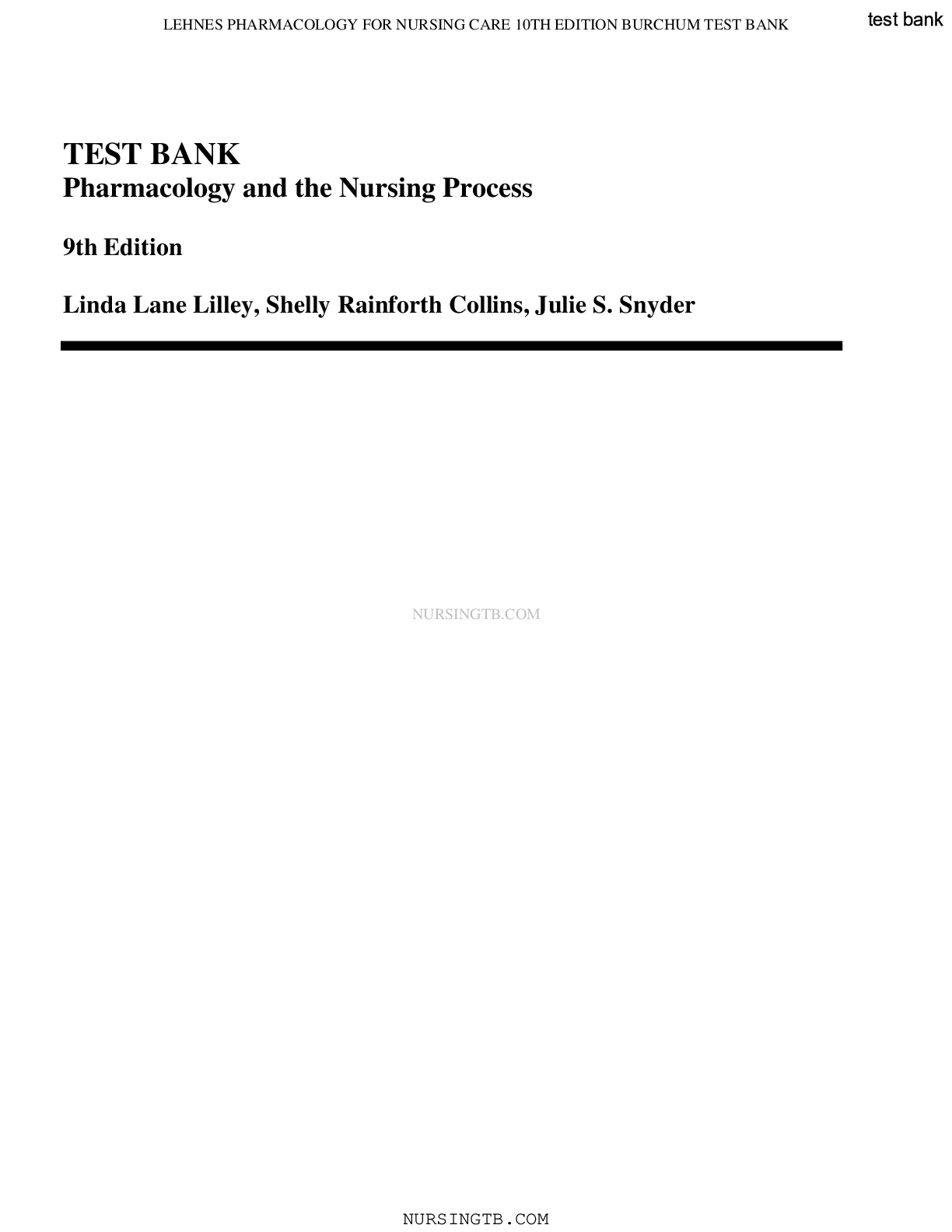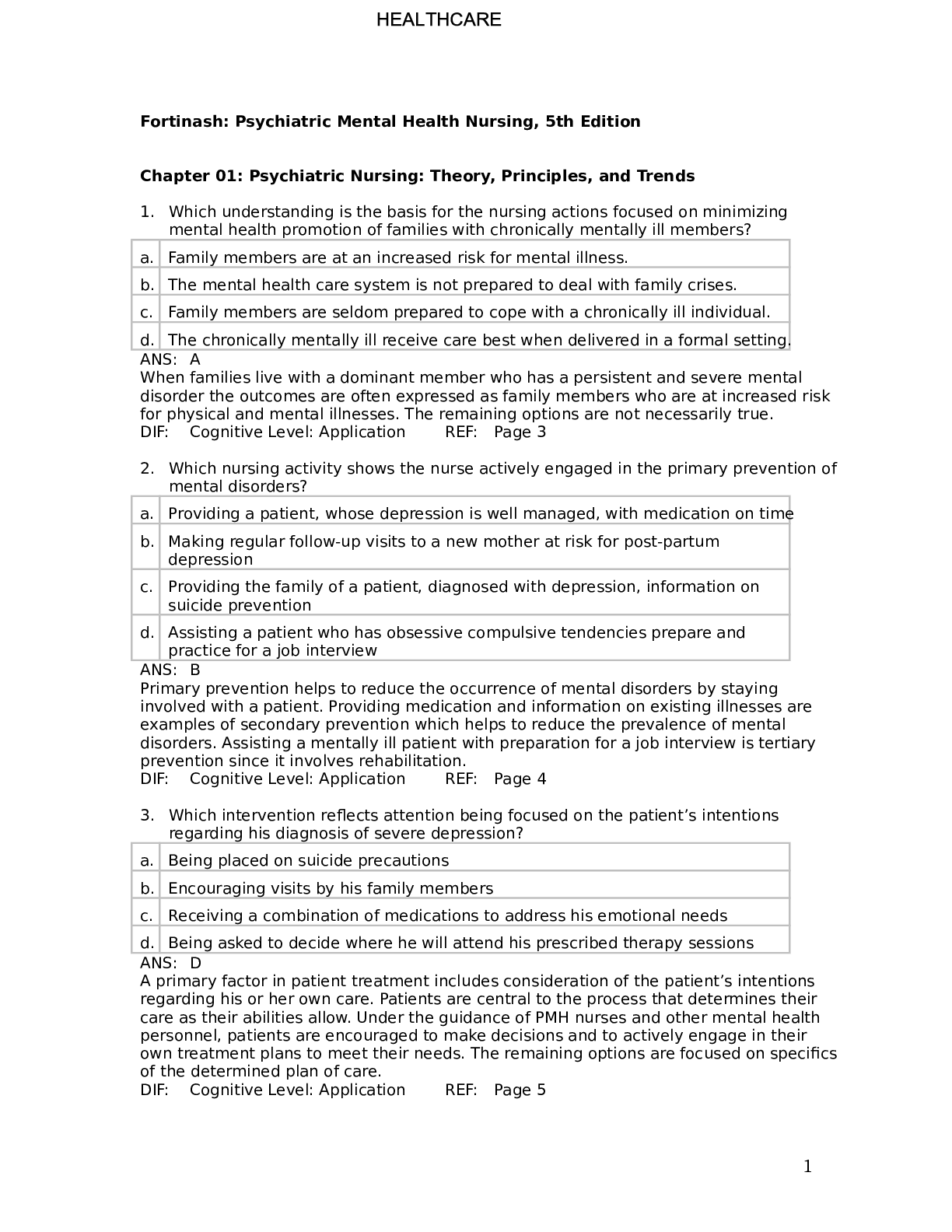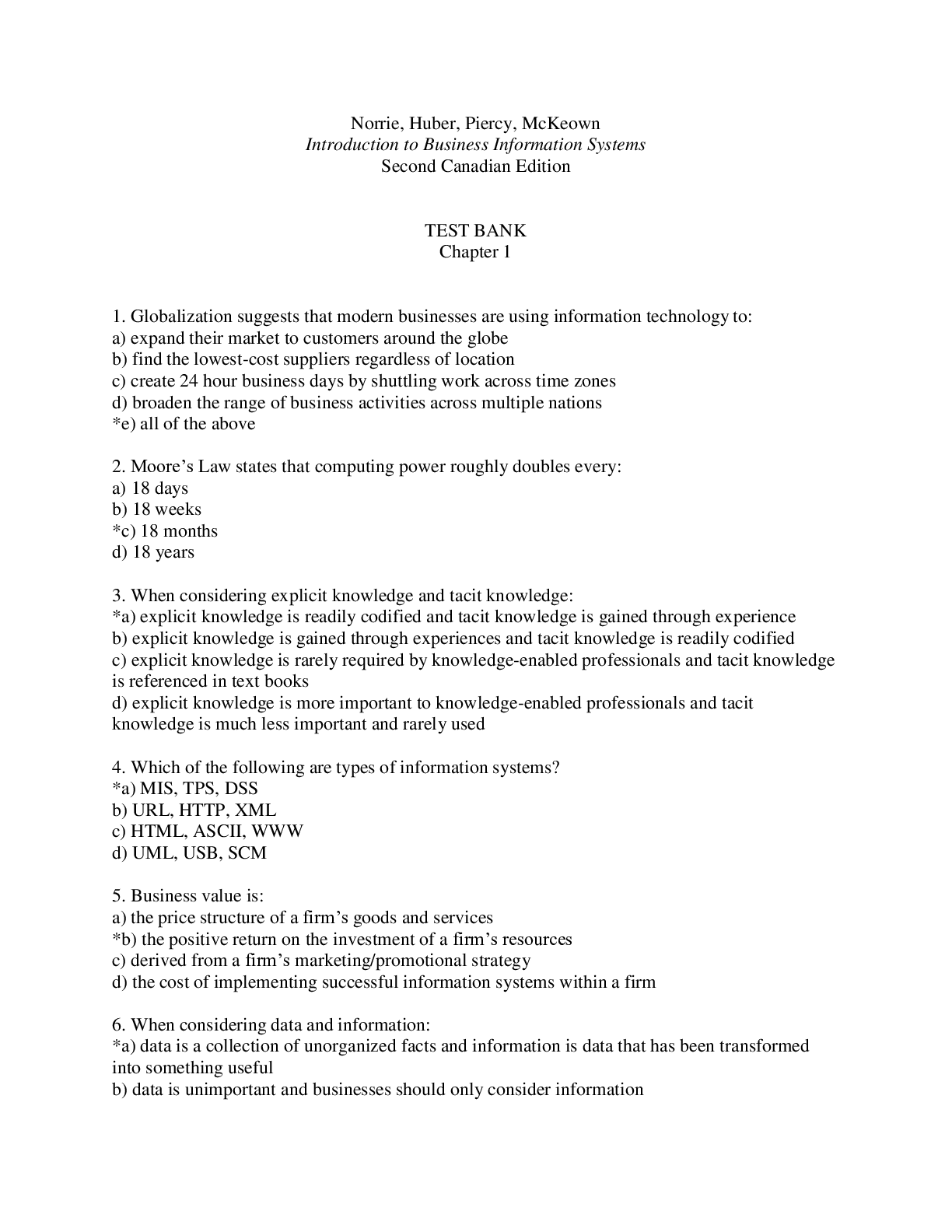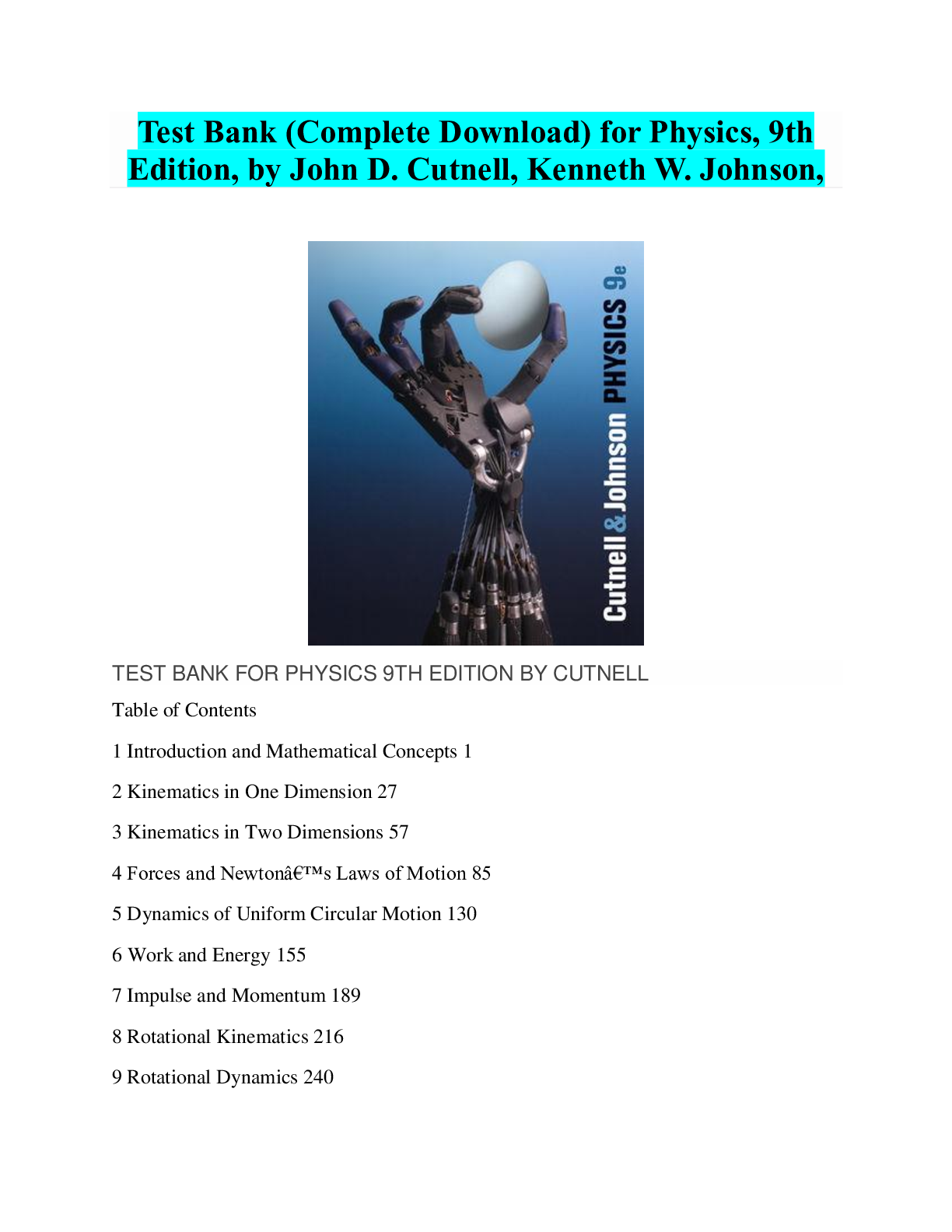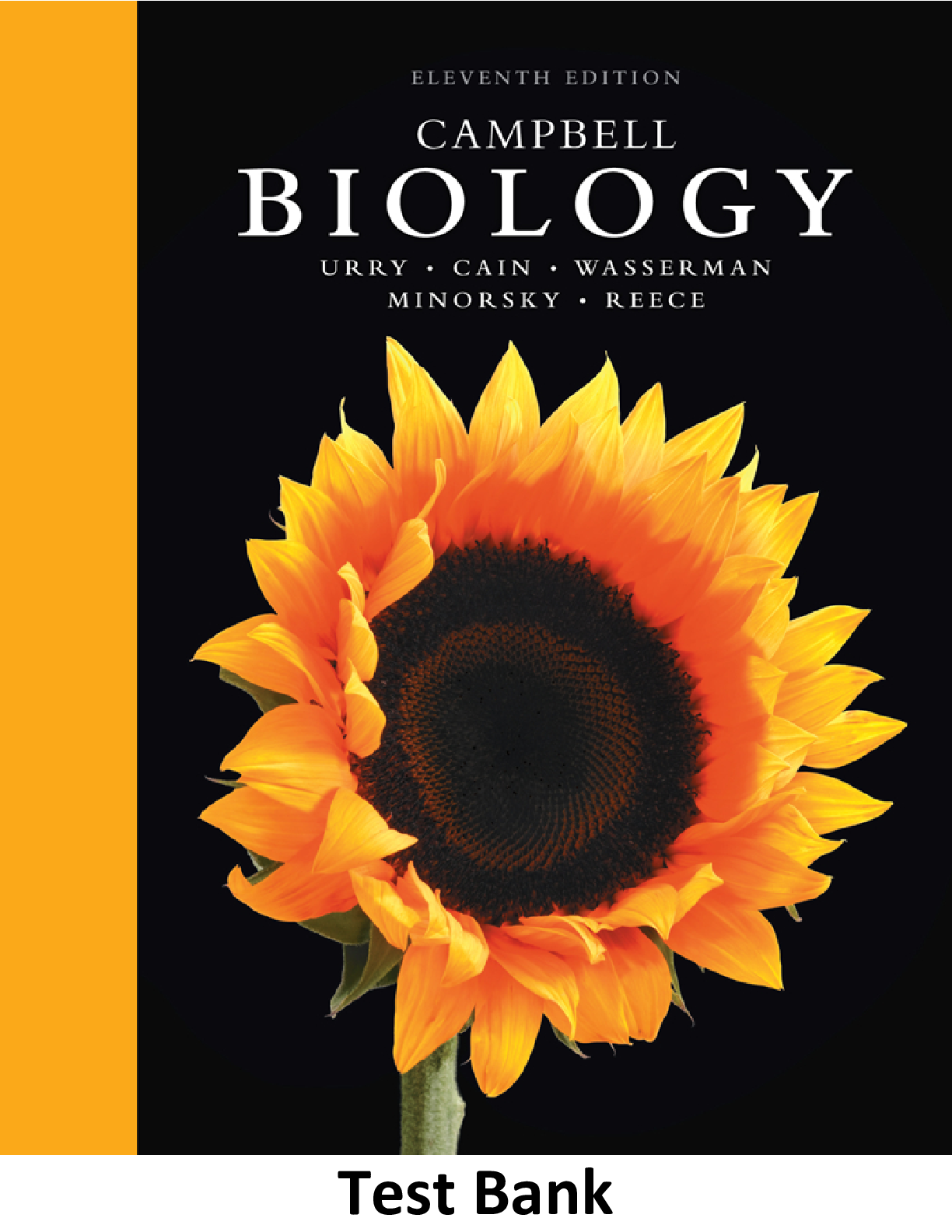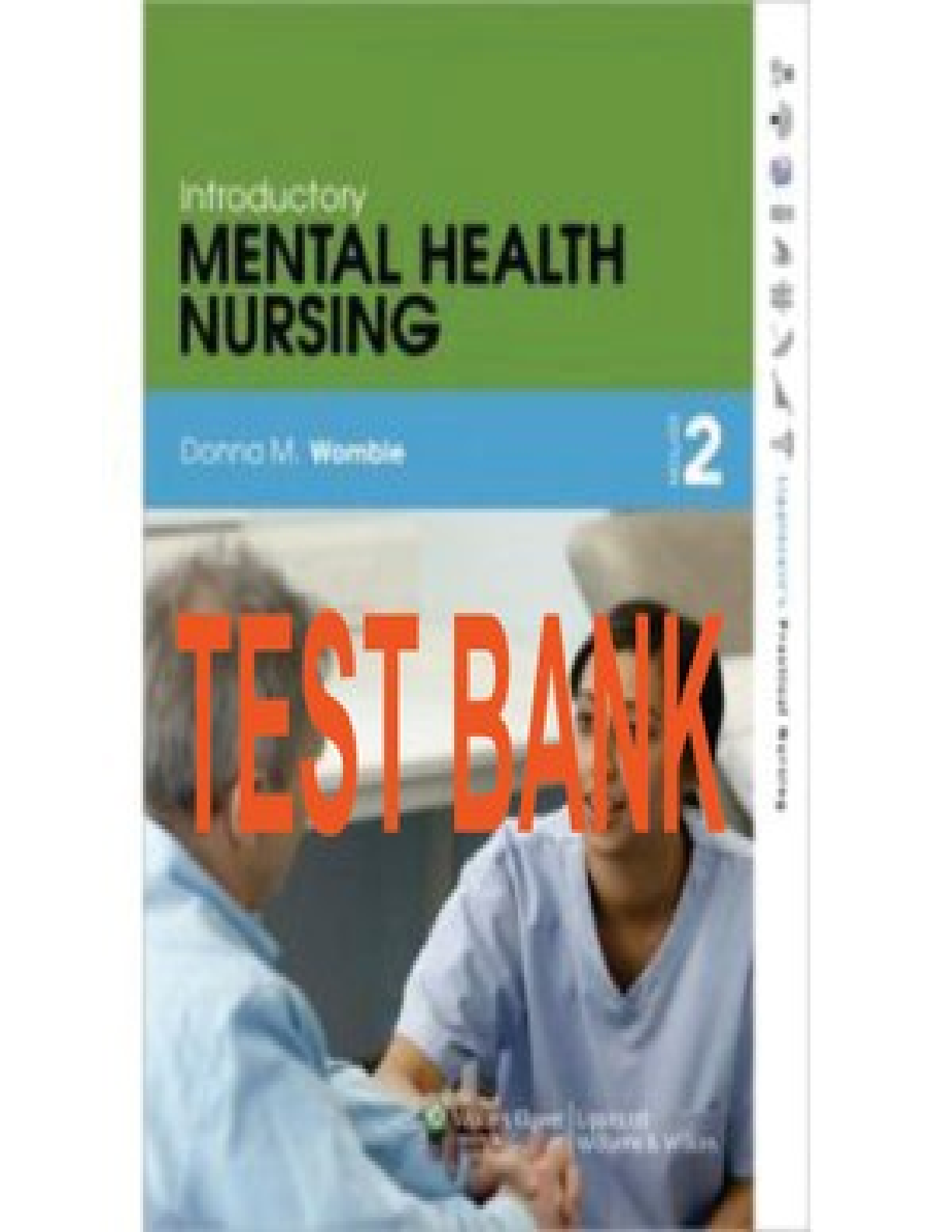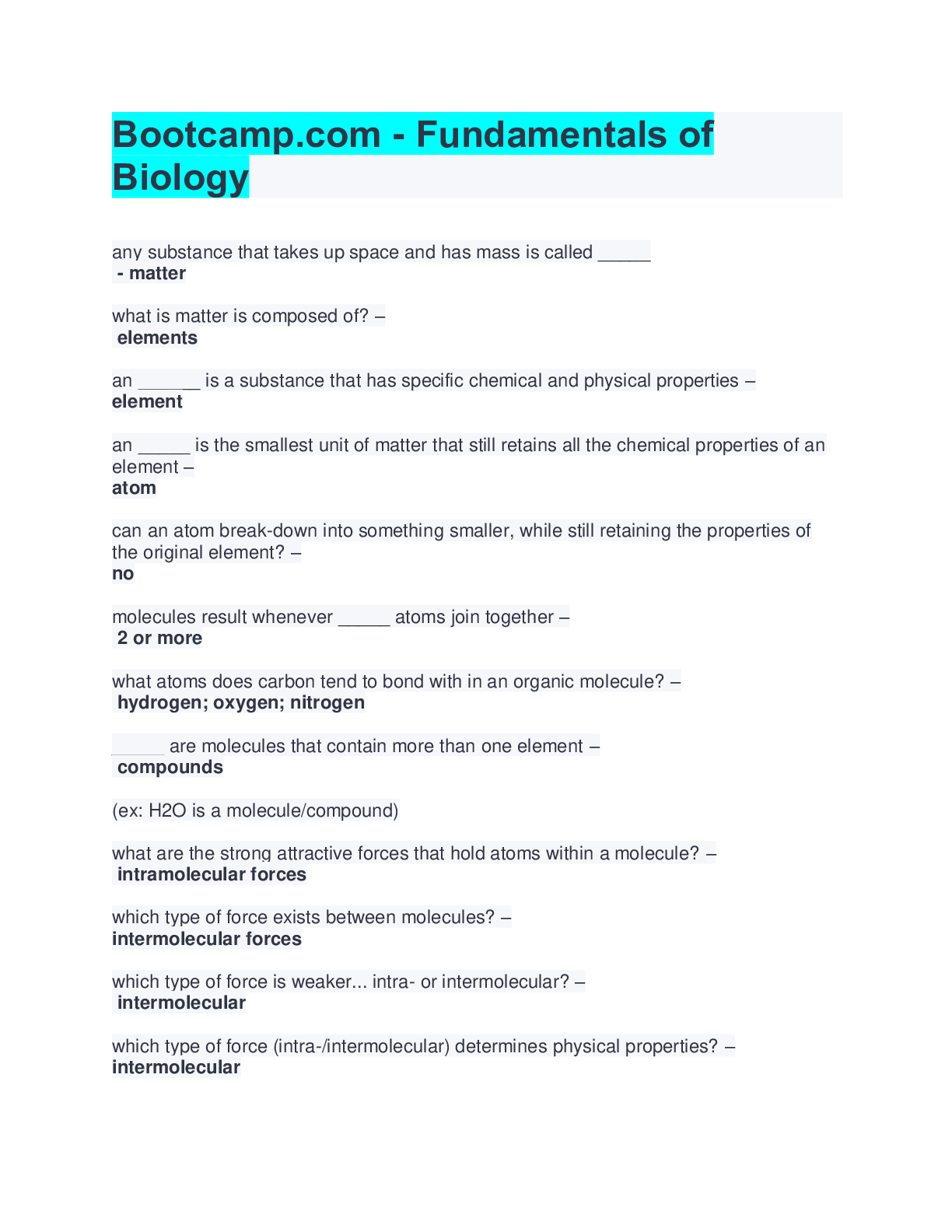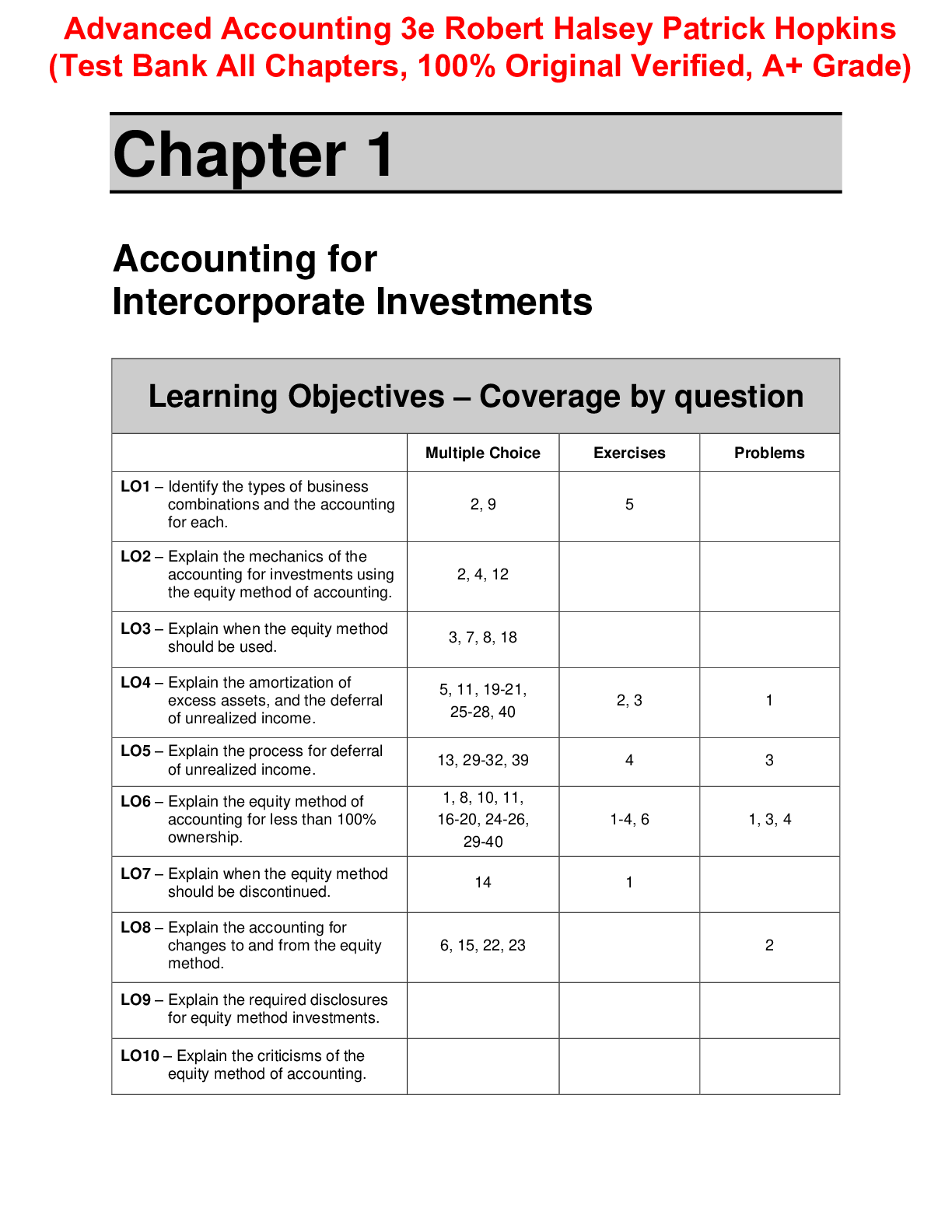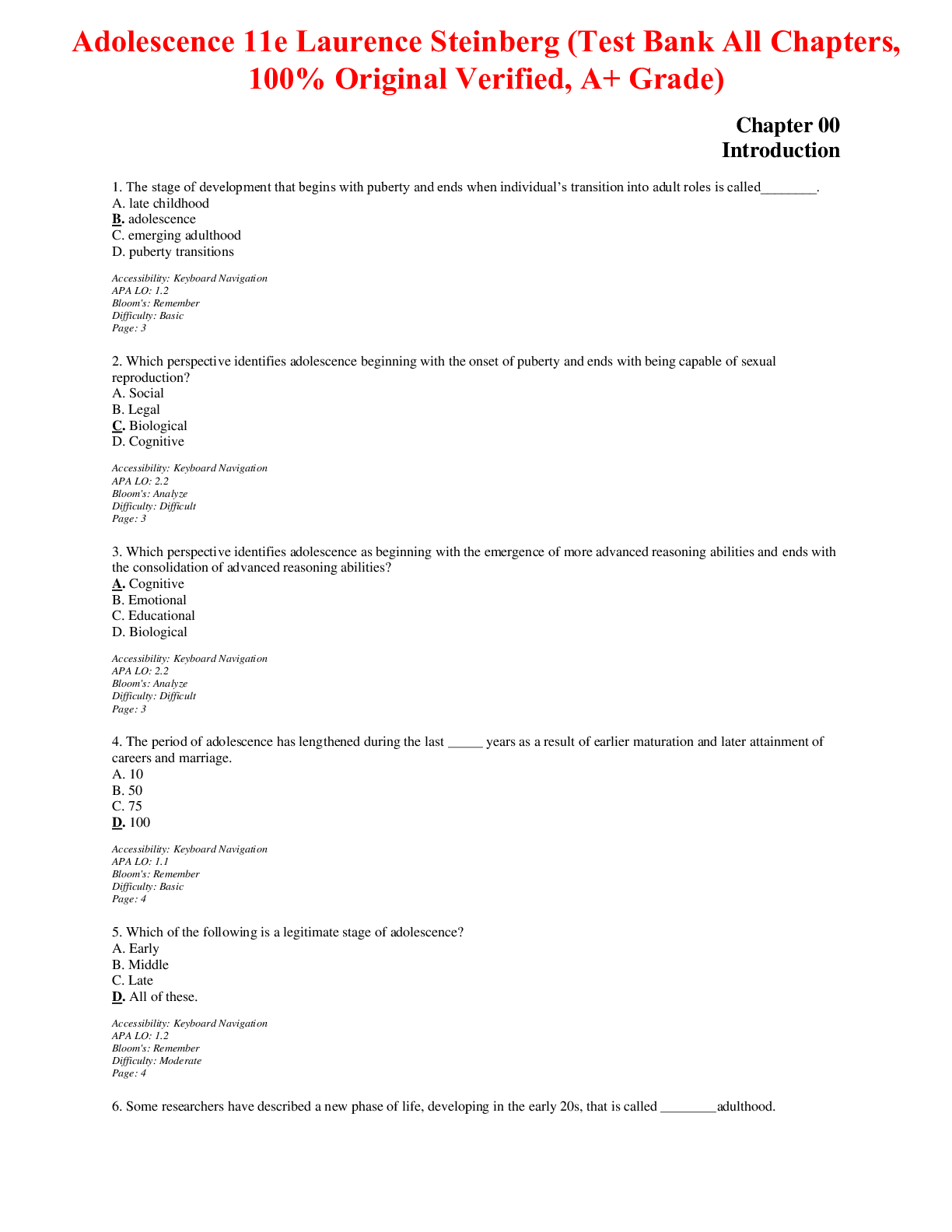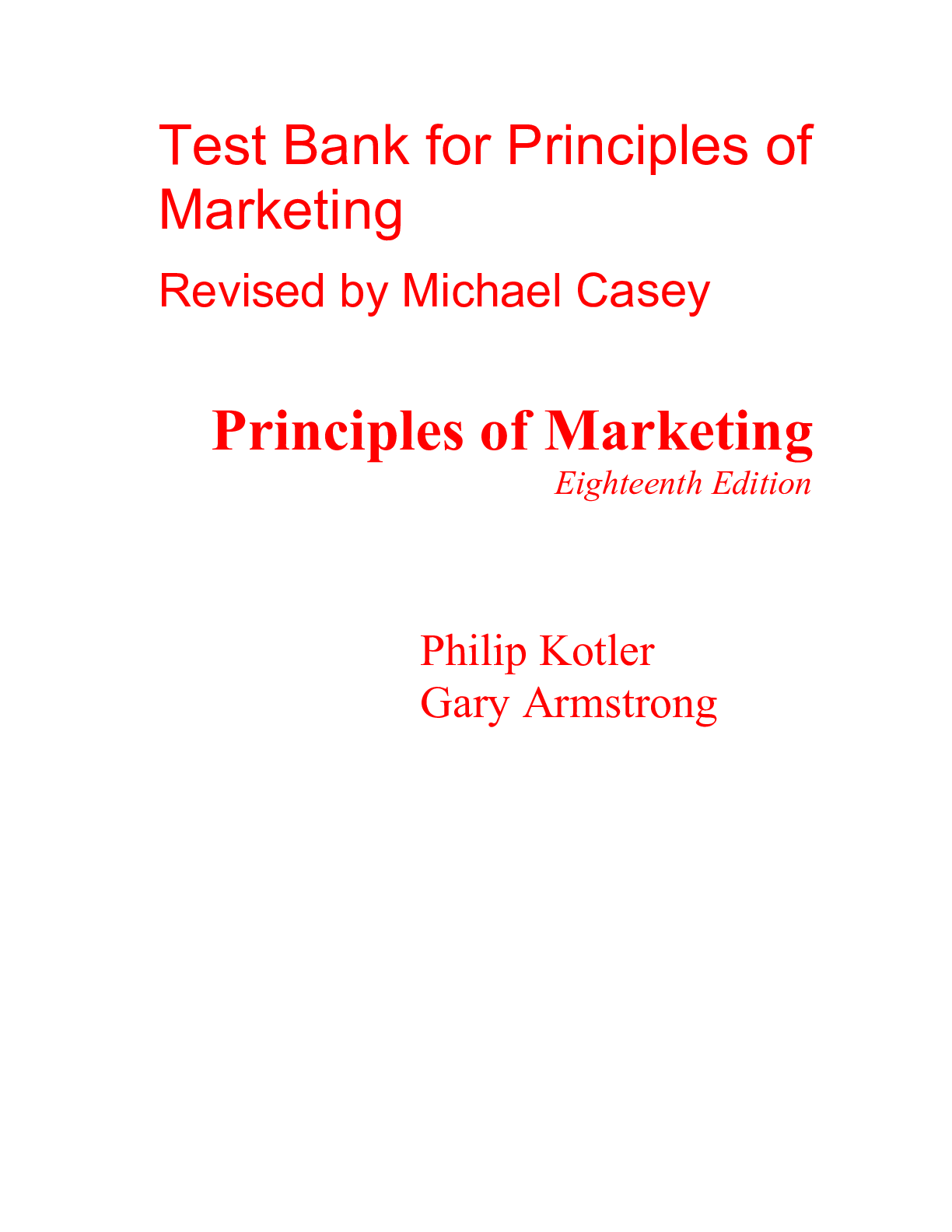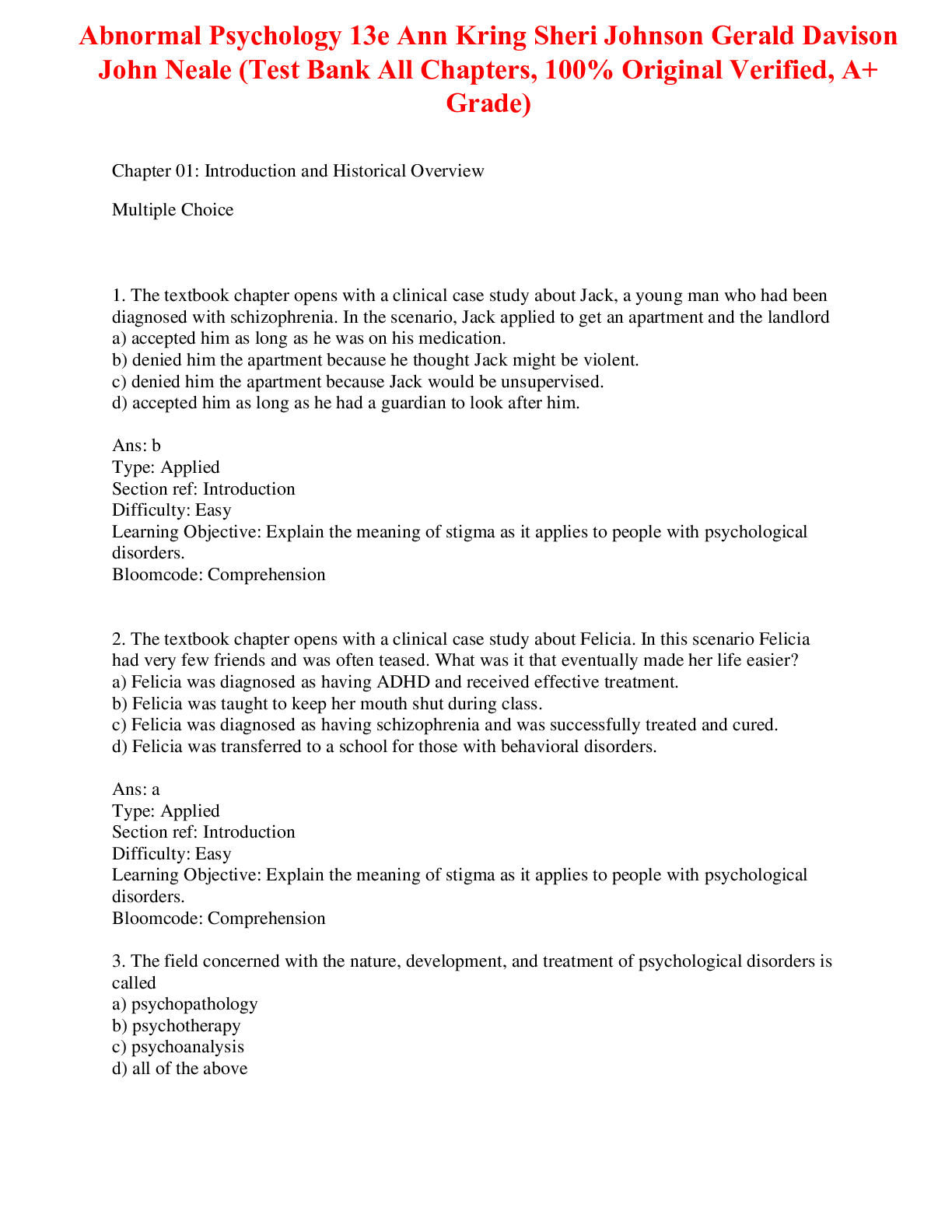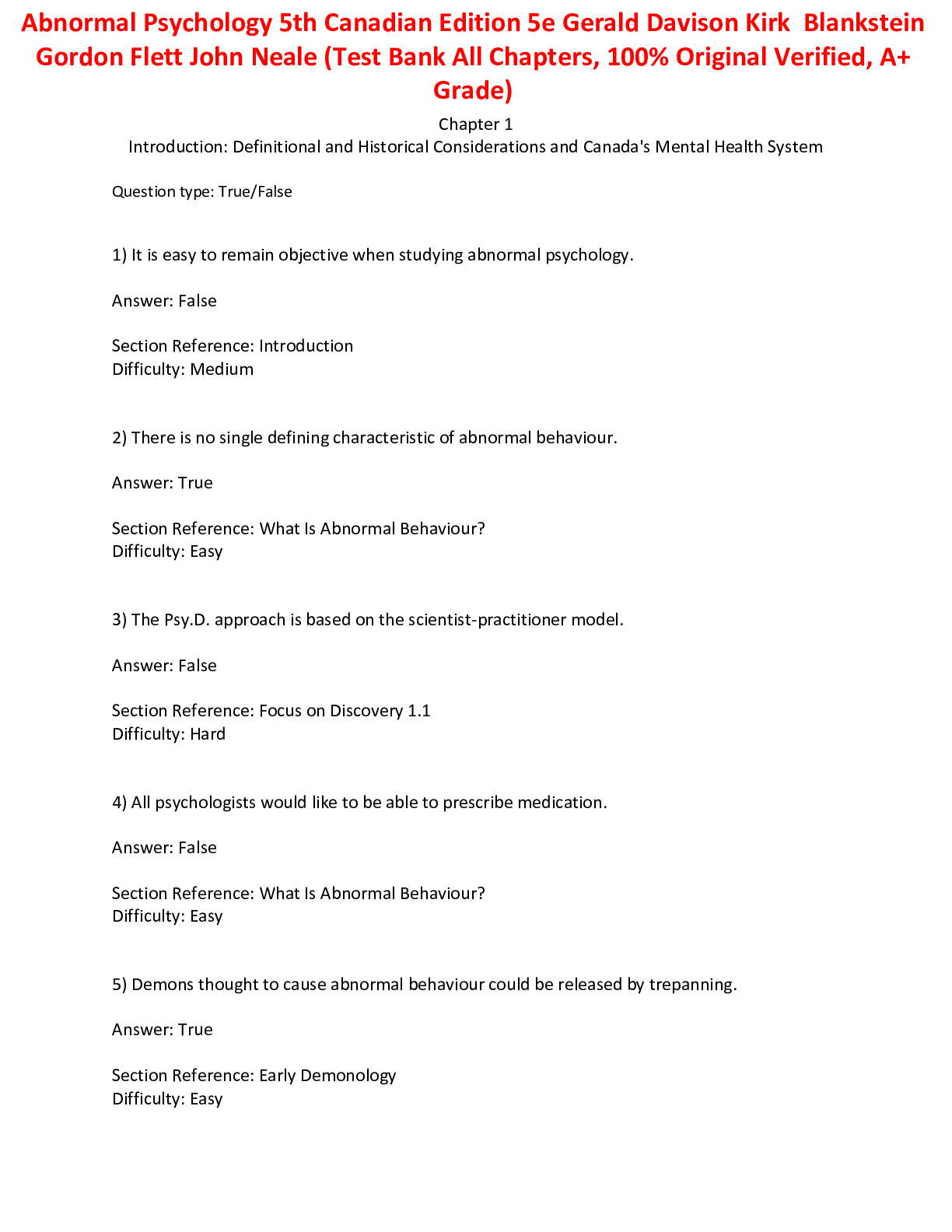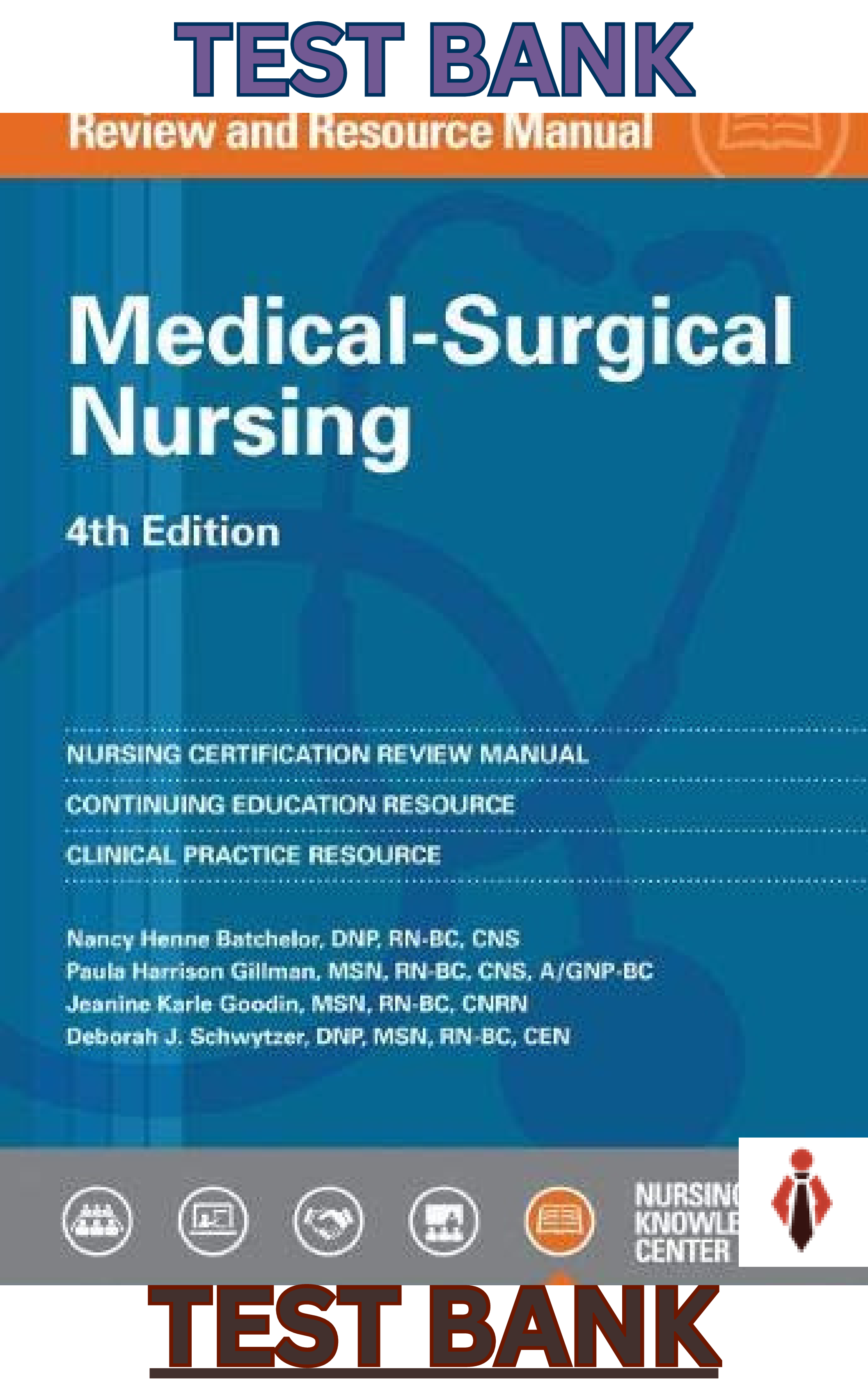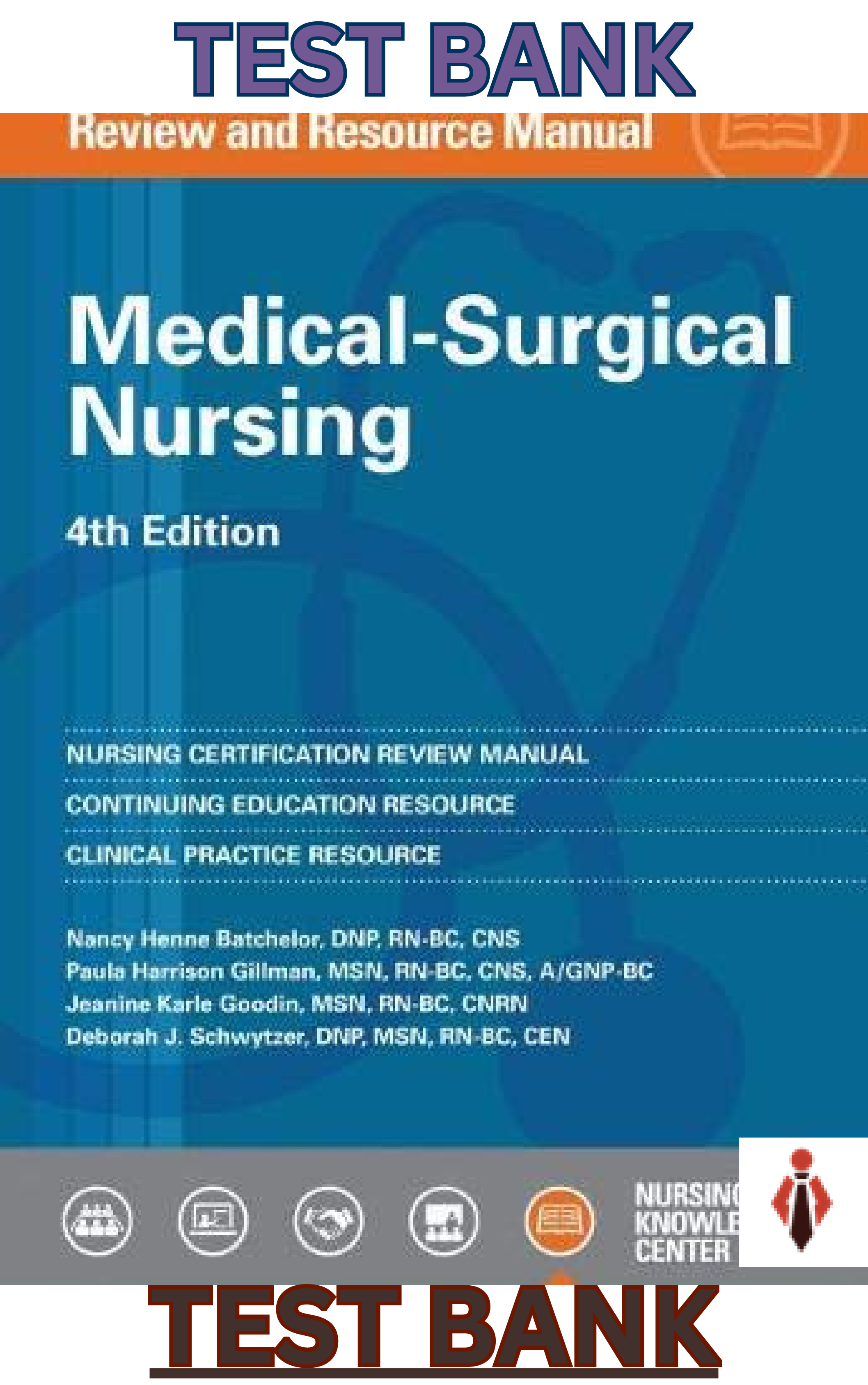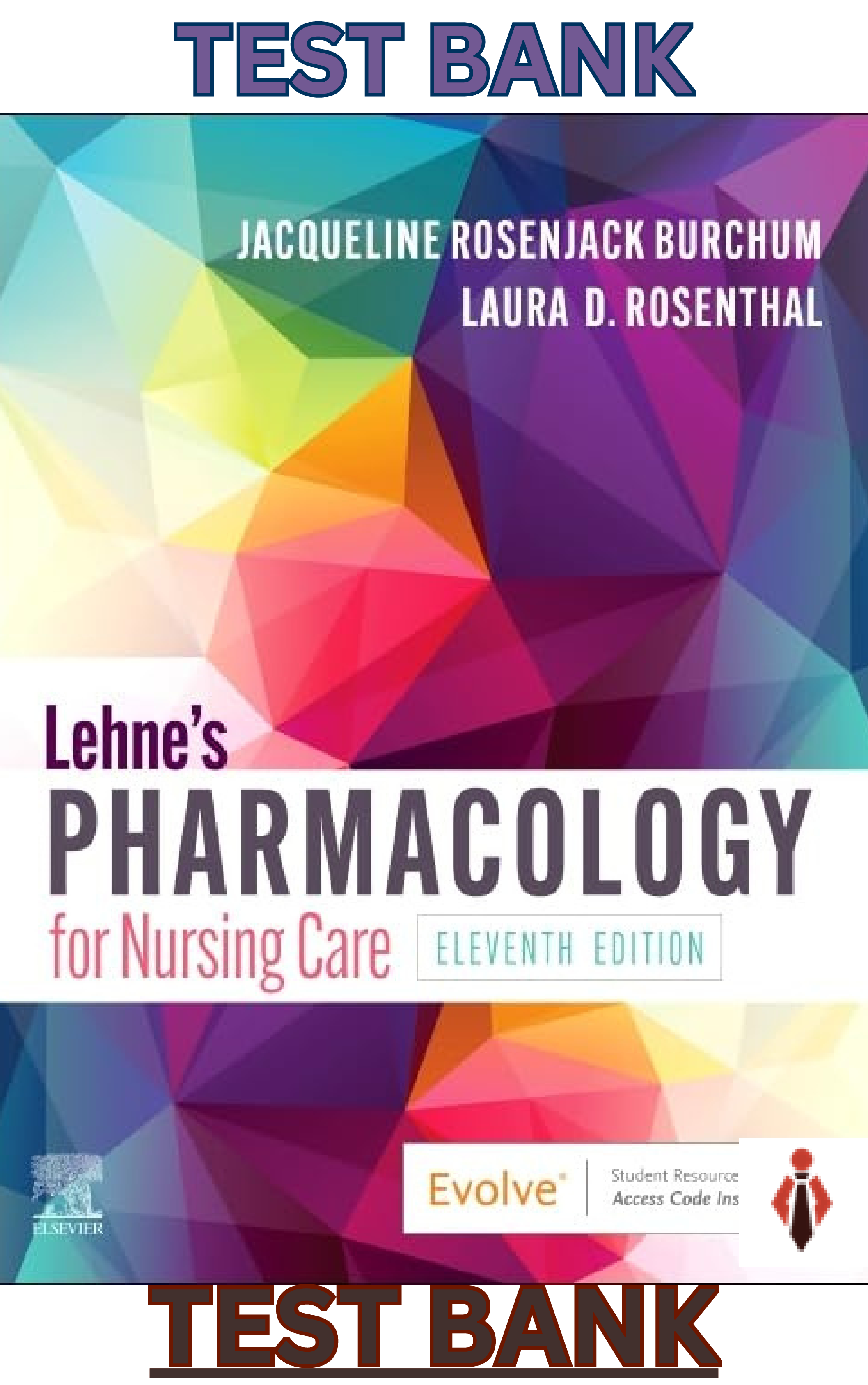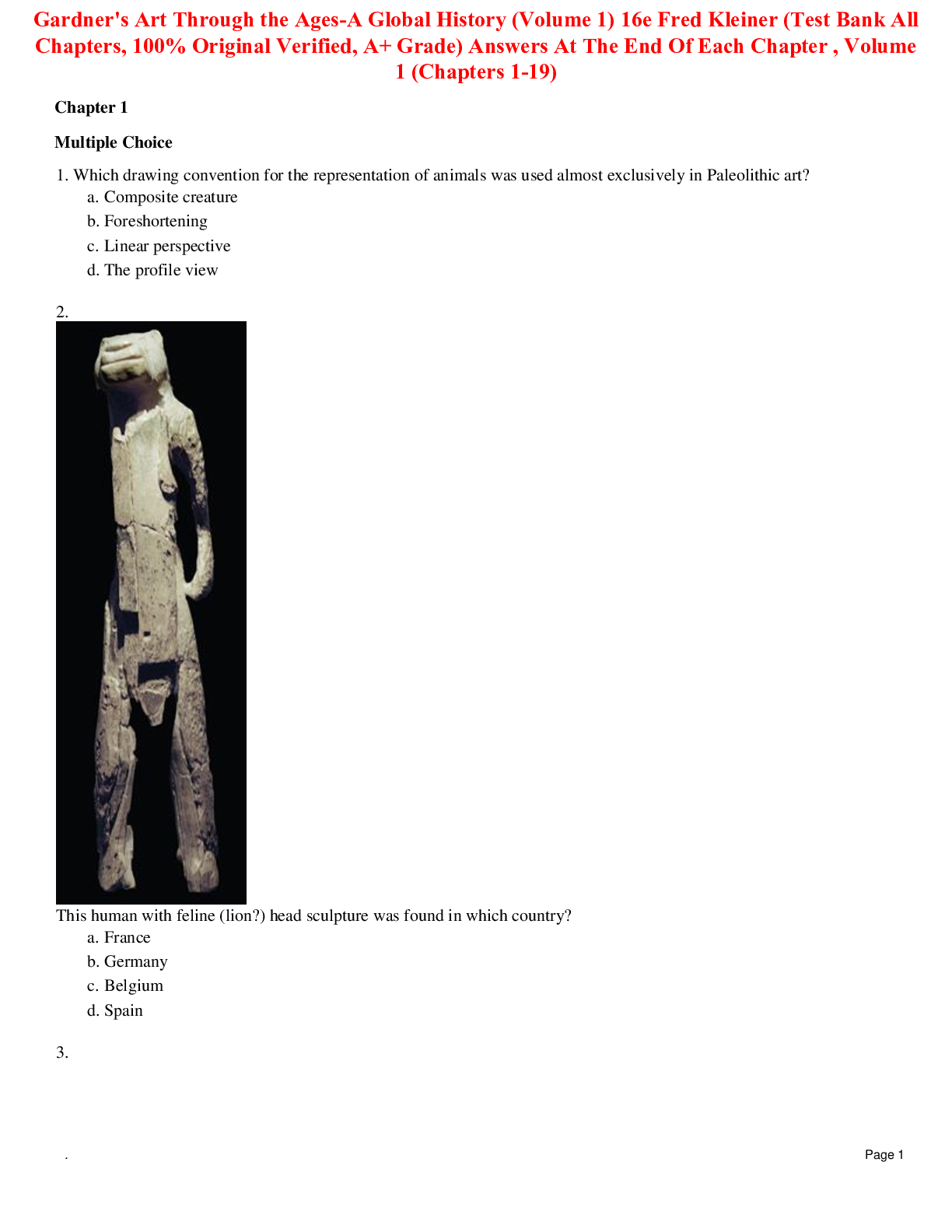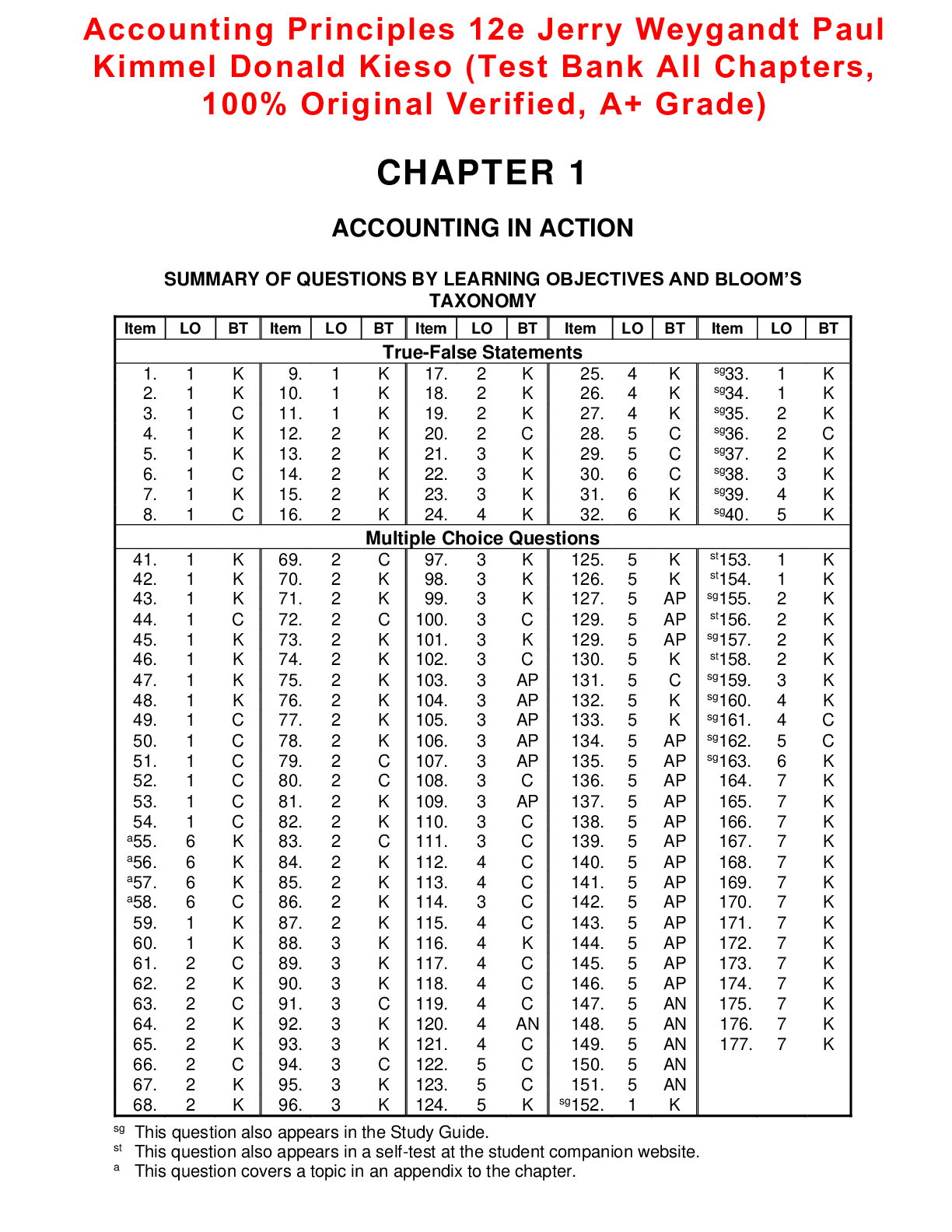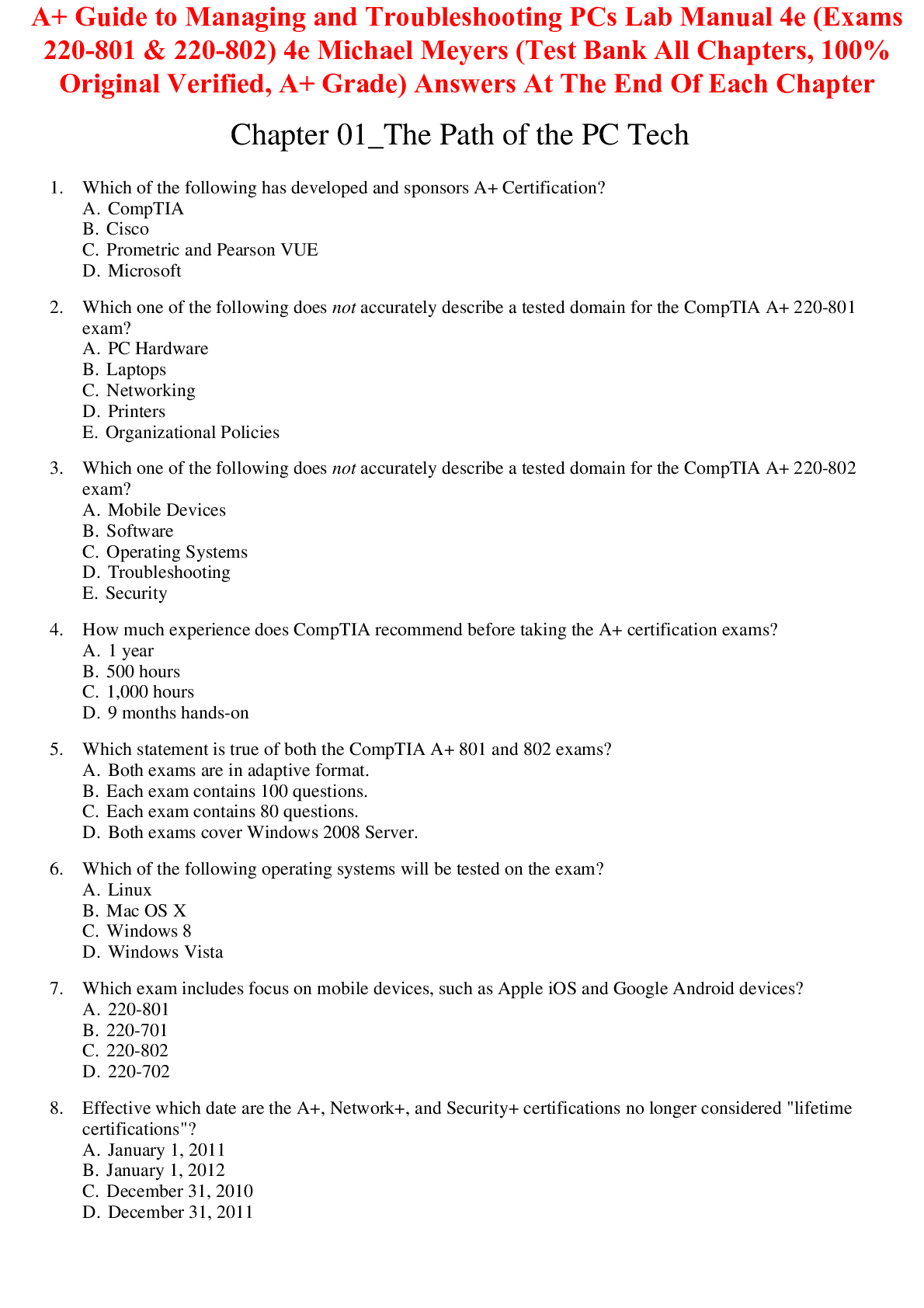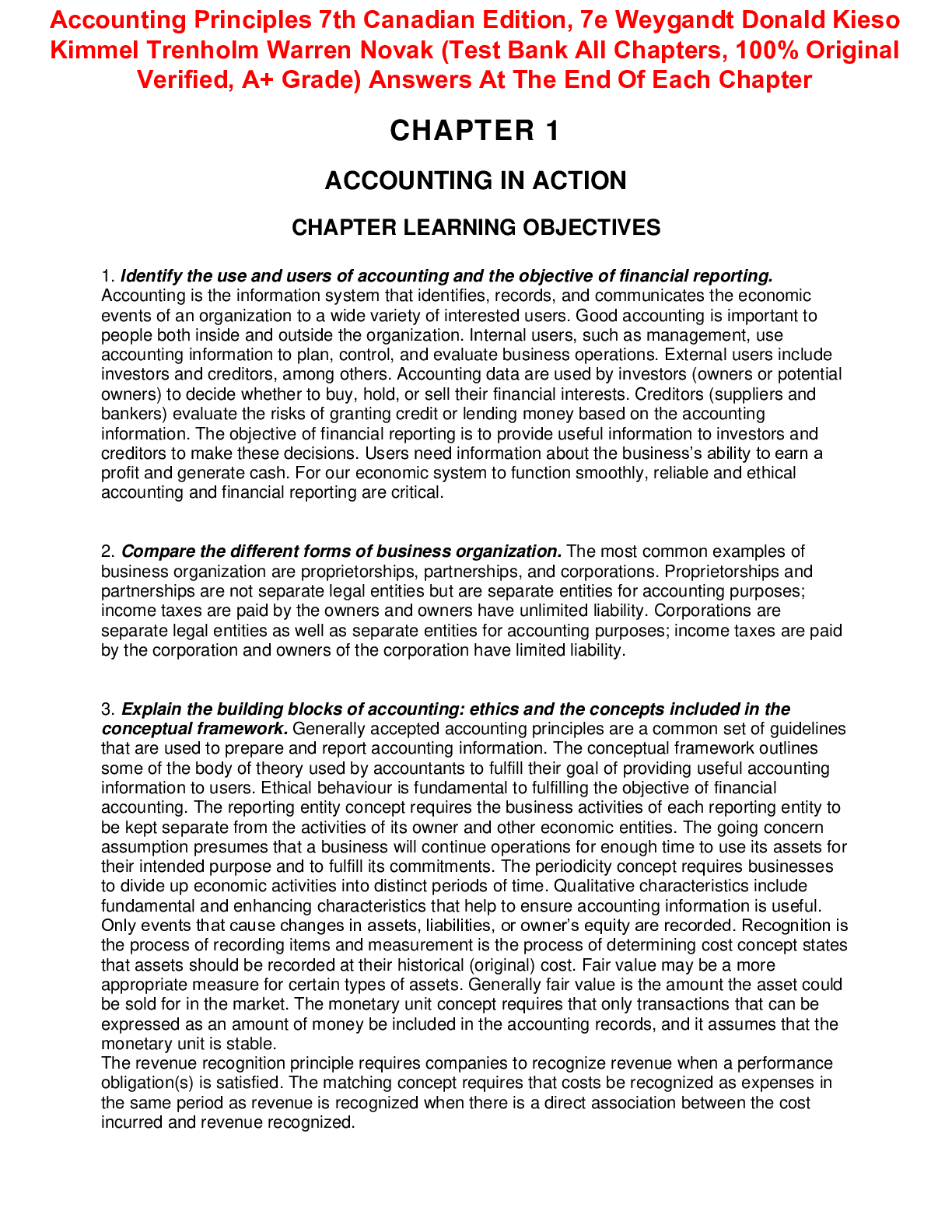*NURSING > TEST BANK > Burns and Grove's The Practice of Nursing Research: Appraisal, Synthesis, and Generation of Evidence (All)
Burns and Grove's The Practice of Nursing Research: Appraisal, Synthesis, and Generation of Evidence 8th Edition Test Bank ( The Test Bank for Understanding Nursing Research 8th Edition by Grove will help you get ready for your upcoming exam. )
Document Content and Description Below
TB for Understanding Nursing Research 8th E by grove Burns and Grove's The Practice of Nursing Research: Appraisal, Synthesis, and Generation of Evidence 8th Edition Test Bank Chapter 1. Discoveri... ng the World of Nursing Research MULTIPLE CHOICE 1. Which best describes evidence-based-practice (EBP)? a.A combination of best research evidence, clinical expertise, and the needs and values of patients. b.A determination of the factors necessary to control patient responses to care. c.The development of population care guidelines applicable to all patients. d.The utilization of quantitative and qualitative studies to enhance patient outcomes. ANS: A Feedback AEvidence-based practice evolves from the integration of the best research evidence with clinical expertise and patient needs and values. BStudies that attempt to find determinants of patient outcomes are generally experimental or quasi-experimental. They may be used to guide EBP but do not completely define it. CEBP is a combination of guidelines and specific patient needs and values. DQuantitative and qualitative studies applied to the evaluation of patient outcomes are part of EBP but do not completely define EBP. PTS: 1 DIF: Cognitive level: Remembering (Knowledge) REF: MCS: 3 2. The nurse is collecting data about the sleep patterns of breastfed babies as part of a larger research study. Which research method will the nurse use when collecting data for this study? a.Control b.Description c.Explanation d.Prediction ANS: B Feedback AControl can be described as the ability to write a prescription to produce the desired outcome. B Description involves identifying and understanding the nature of nursing phenomena and the relationships among these phenomena. C Explanation clarifies the relationships among phenomena and identifies why certain events occur. D Through prediction, the probability of a specific outcome can be estimated in a given situation. PTS: 1 DIF: Cognitive level: Understanding (Comprehension) REF: MCS: 6 3. The nurse is participating in a study and is collecting data identifying the number of obese adults whose parents were also obese or overweight. Which research method is being used in this study? a.Control b.Description c.Explanation d.Prediction ANS: D Feedback AControl indicates the ability to use a prescribed intervention to produce a desired outcome. BDescription involves identifying and understanding the nature of nursing phenomena and the relationships among these phenomena. CExplanation clarifies the relationships among phenomena and identifies why certain events occur. DThrough prediction the probability of a specific outcome can be estimated in a given situation. By knowing the percentage of parents of obese adults who were obese, the probability of predicting this may be calculated. PTS:1DIF:Cognitive level: Applying (Application) REF: pp. 7-8 4. The nurse reviews a study in which adherence to an asthma action plan is compared among groups of adolescents who received different asthma education. Which research method does this represent? a.Control b.Description c.Explanation d. Prediction ANS: C Feedback A Control indicates the ability to use a prescribed intervention to produce a desired outcome. B Description involves identifying and understanding the nature of nursing phenomena and the relationships among these phenomena. C Explanation clarifies the relationships among phenomena and identifies why certain events occur. D Through prediction, the probability of a specific outcome can be estimated in a given situation. PTS:1DIF:Cognitive level: Applying (Application) REF: MCS: 7 5. A nurse manager is interested in learning which attitudes among staff nurses may indicate relative risk of needle-stick injuries. To study this, the nurse manager will employ which method of study? a.Control b.Description c.Explanation d.Prediction ANS: D Feedback AControl indicates the ability to use a prescribed intervention to produce a desired outcome. BExplanation clarifies the relationships among phenomena and identifies why certain events occur. CDescription involves identifying and understanding the nature of nursing phenomena and the relationships among these phenomena. DThrough prediction, the probability of a specific outcome can be estimated in a given situation. PTS:1DIF:Cognitive level: Applying (Application) REF: pp. 7-8 6. Which is the most important result of Florence Nightingales data collection and statistical analysis during the Crimean War? a.Bringing awareness of the rigors of war to the general public. b.Developing a process for statistical analysis and nursing documentation. c.Identifying and defining the role of nurses in modern health care. d.Using clinical research to evaluate the importance of sanitation, clean drinking water, and adequate nutrition. ANS: D Feedback AThis was not the most important result BThis was not the most important result CThis was not the most important result DNightingales research enabled her to instigate attitudinal, organizational, and social changes, including the militarys approach to the care of the sick and societys sense of responsibility for testing public water, improving sanitation, and preventing starvation to decrease morbidity and mortality rates. PTS: 1 DIF: Cognitive level: Understanding (Comprehension) REF: MCS: 11 7. The nurse participates in data collection in a study in which two different pain management protocols are used with randomly assigned patients to measure differences in postoperative recovery time. Which method of study is this? a.Control b.Correlation c.Description d.Explanation ANS: A Feedback AControl indicates the ability to use a prescribed intervention to produce a desired outcome. BCorrelation examines the relationships between different phenomena. CDescription involves identifying and understanding the nature of nursing phenomena and the relationships among these phenomena. DExplanation clarifies the relationships among phenomena and identifies why certain events occur. PTS:1DIF:Cognitive level: Applying (Application) REF: MCS: 8 8. The development of nursing theories and conceptual models in the late 1960s and 1970s served to: a.determine the effectiveness of nursing interventions. b.establish the concept of evidence-based practice. c.provide funding for nursing research. d.provide direction for nursing research. ANS: D Feedback AOutcome studies are used to determine the effectiveness of nursing interventions. BThe concept of EBP was developed in the 1970s and promoted by the ANCC Magnet Designation program. CThe NINR seeks to provide funding for nursing research. DThe theories developed in the 1960s and 1970s helped to direct future nursing research. PTS: 1 DIF: Cognitive level: Understanding (Comprehension) REF: pp. 11-12 9. Under Ada Sue Hinshaw, the National Institute of Nursing Research (NINR) began to change its focus to: a.funding nursing rather than medical research. b.evaluating outcomes rather than process studies. c.increasing the status and funding for nursing research. d.supporting the dissemination of nursing research. ANS: C Feedback AThe change in focus from medical to nursing research came about with the first nursing programs. Specialty nursing organizations today and some nursing researchers still conduct medical research for specific studies. BOutcomes research emerged in the 1980s and 1990s to document the effectiveness of health care services. CUnder Ada Sue Hinshaw, the national Center for Nursing Research (NCNR) changed its name to the NINR to increase the status and funding of nursing research. DThe NCNRs purpose was to support the dissemination of nursing research. PTS: 1 DIF: Cognitive level: Remembering (Knowledge) REF: pp. 12-13 10. An emphasis of the American Nurses Credentialing Center (ANCC) Magnet Hospital Designation Program for Excellence in Nursing is: a.research and development of clinical practice guidelines. b.putting qualitative research into practice in clinical settings. c.using standard nursing care plans based on outcomes research. d.utilizing evidence-based practice in nursing. ANS: D Feedback AClinical practice guidelines are a more recent phenomenon, using evidence-based research, expert opinion, and patient needs and values to standardize care. BQualitative research was introduced in the late 1970s to gain insight into the phenomena related to nursing. COutcomes research was important in the 1980s to 1990s to document the effectiveness of health care services. DANCC implemented the Magnet Hospital Designation Program for Excellence in Nursing Service in 1990 that emphasized EBP for nursing. PTS: 1 DIF: Cognitive level: Remembering (Knowledge) REF: pp. 12-13 11. In a position statement in 2006, the American Association of Colleges of Nursing (AACN) identified a need to: a.acquire clinical knowledge and expertise. b.focus on evidence-based practice. c.fund academic nursing research. d.prepare a workforce of nurse scientists. ANS: D Feedback ABasic nursing education focuses on clinical knowledge and expertise. BEvidence-based practice is a focus of ANCC and the Magnet Designation Program for Excellence in Nursing Service. CThe NINR focuses on funding for nursing research. DThe AACN identified the importance of creating a research culture, providing high-quality educational programs to prepare a workforce of nurse scientists, develop a sound research structure, and obtain funding for nursing research. PTS: 1 DIF: Cognitive level: Understanding (Comprehension) REF: MCS: 14 12. The lead agency designated to improve health care quality is: a.Agency for Healthcare Research and Quality (AHRQ). b.American Nurses Credentialing Center (ANCC). c.Quality and Safety Education for Nurses (QSEN). d.National Institute for Nursing Research (NINR). ANS: A Feedback AAHRQ is a scientific partner with the public and private sectors to improve the quality and safety of patient care. BANCC provides credentialing for advanced practice nurses and for Magnet Designation for Excellence in Nursing Service CQSEN is focused on developing the requisite skills, knowledge, and attitude statements for the competencies for prelicensure and graduate education. DThe National Institute of Nursing Research, originally the National Center for Nursing Research, is a federally funded arm of the National Institutes of Health, providing nursing with federal support for nursing research priorities. PTS: 1 DIF: Cognitive level: Remembering (Knowledge) REF: pp. 12-13 13. To help fulfill the mission of the National Institute for Nursing Researchto promote and improve the health of individuals, families, communities, and populationsa study may be conducted which: a.assesses the effectiveness of strategies for weight management in patients with type 2 diabetes. b.compares the attitudes of nurses toward clients with type 1 and type 2 diabetes. c.generates up-to-date nursing diagnoses reflecting the needs of clients with type 2 diabetes. d.reviews hospital nurses adherence to glucose-monitoring guidelines for patients with type 2 diabetes. ANS: A Feedback AA study that assesses the effectiveness of interventions helps to improve the health of patient populations by identifying appropriate strategies. BA comparison of attitudes is a descriptive study that does not improve outcomes. CA study to generate nursing diagnoses does not directly affect patient outcomes. DA study reviewing adherence to guidelines seeks to provide data for quality assurance. PTS:1DIF:Cognitive level: Applying (Application) REF: pp. 14-15 14. Which best describes the Quality and Safety Education for Nurses (QSEN) competency for evidence-based practice (EBP)? a.Adhering to published guidelines to provide care for a specific population. b.Empowering clients to choose among effective disease management strategies. c.Relying on expert knowledge to guide care plan development for an individual patient. d.Using evidence gained solely from experimental studies to guide care. ANS: B Feedback AStrict adherence to guidelines does not take the patient/family preferences into account. BThe QSEN competency for EBP is defined as integrating the best evidence with clinical expertise and patient/family preferences. CEBP does not rely solely on expert knowledge or experimental studies. DAlthough experimental studies provide the highest level of study data, EBP does not rely soley on experiemental studies.. PTS:1DIF:Cognitive level: Applying (Application) REF: MCS: 15 15. Through knowledge gained from her phenomenological qualitative study identifying levels of experience of professional nurses, Patricia Benner would identify which nurse as an expert? a.A hospice nurse who values the unique wishes of each patient when providing palliative care. b.A medical-surgical nurse who organizes care for a group of patients to ensure timely administration of medications. c.A neonatal intensive care nurse who is skilled in inserting peripherally inserted central catheters. d.A pediatric nurse who notes subtle changes and intervenes to prevent respiratory failure. ANS: D Feedback AThe proficient nurse views the patient as a whole and recognizes that each patient responds differently to illness and health. BThe competent nurse is able to achieve goals and plans and to take conscious actions to organize and provide efficient care. CThe NIC nurse is also an example of a competent nurse who is skilled in a procedure. DThe expert nurse has an extensive background of experience and is able to identify and accurately intervene skillfully in a situation. The pediatric nurse in this case recognizes subtle changes and is able to act to prevent serious circumstances. Chapter 2. Evolution of Research in Building Evidence-Based Nursing Practice MULTIPLE CHOICE 1. In which way did Florence Nightingale contribute to evidence-based practice? a. She conducted research on outcomes and the power of nursing for change. b. She was the first woman elected to the Royal Statistical Society. c. She gathered data that changed the care of hospitalized soldiers. d. She calculated mortality rates under varying conditions. ANS: C Nightingale gathered data on soldier morbidity and mortality rates and the factors influencing them and presented her results in tables and pie charts, a sophisticated type of data presentation for the period. Nightingales research enabled her to instigate attitudinal, organizational, and social changes. She changed the attitudes of the military and society toward the care of the sick. The military began to view the sick as having the right to adequate food, suitable quarters, and appropriate medical treatment, which greatly reduced the mortality rate. DIF: Cognitive Level: Application REF: MCS: 17 2. If a nurse manager wants to study how well last years policies governing implementation of a bundle of interventions to prevent cross-contamination of MRSA have been working in her units, which of the following strategies would she use? a. Outcomes research b. Intervention research c. Ethnographic research d. Experimental research ANS: A Outcomes research emerged as an important methodology for documenting the effectiveness of health care services in the 1980s and 1990s. This type of research evolved from the quality assessment and quality assurance functions that originated with the professional standards review organizations (PSROs) in 1972. During the 1980s, William Roper, the director of the Health Care Finance Administration (HCFA), promoted outcomes research for determining the quality and cost-effectiveness of patient care. Intervention research investigates the effectiveness of a nursing intervention in achieving the desired outcome or outcomes in a natural setting. Through the use of ethnographic research, different cultures are described, compared, and contrasted to add to our understanding of the impact of culture on human behavior and health. Experimental studies have three main characteristics: (1) a controlled manipulation of at least one treatment variable (independent variable), (2) administration of the treatment to some of the subjects in the study (experimental group) and not to others (control group), and (3) random selection of subjects or random assignment of subjects to groups, or both. Experimental studies usually are conducted in highly controlled settings, such as laboratories or research units in clinical agencies. DIF: Cognitive Level: Analysis REF: MCS: 22 3. A researcher publishes a paper describing how faith, pain, adherence to therapy, and meditation interact during the rehabilitation process. The description of the process is based on many interviews the researcher conducted with persons during and following rehabilitation experiences. The methodology is a. Ethnography b. Phenomenology c. Historical research d. Grounded theory ANS: D Grounded theory methodology emphasizes observation and the development of practice-based intuitive relationships among variables. Throughout the study, the researcher formulates, tests, and redevelops propositions until a theory evolves. The theory developed is grounded, or has its roots in, the data from which it was derived. DIF: Cognitive Level: Synthesis REF: MCS: 27 4. A panel of researchers conducts several studies, all drawn from an existent hospital and clinic database. The studies focus on quality and effectiveness within that system. The specific studies address mortality rates in elders within a year after hip fracture, functional outcomes six months after admission to a neurosurgical ICU after traumatic brain injury, rate of nurse injuries in an emergency department, and number of patient falls on various floors of the hospital. What type of research is this? a. Experimental research b. Outcomes research c. Ethnographic research d. Grounded theory research ANS: B The spiraling cost of health care has generated many questions about the quality and effectiveness of health care services and the patient outcomes. Consumers want to know what services they are buying, and whether these services will improve their health. Health care policy makers want to know whether the care is cost-effective and of high quality. These concerns have promoted the development of outcomes research, which examines the results of care and measures the changes in health status of patients. It can also examine costs related to care delivery within a hospital system. DIF: Cognitive Level: Comprehension REF: MCS: 27 5. A researcher designs a study. It depends on questionnaires for data, it has a clear purpose statement, it provides its results as a narrative without statistical analysis, and it makes general suggestions for practice. What type of research is this? a. Qualitative research b. Outcomes research c. Intervention research d. Quantitative research ANS: D Quantitative research is a formal, objective, systematic process in which numerical data are used to obtain information about the world. Qualitative research is also systematic, but it is a holistic, interactive, and subjective approach to describe life experiences and identify their meaning. Both types of research have a purpose statement and can use a survey instrument; however, neither depends on surveys for data. Both can contain suggestions for practice. Qualitative research results are presented as a narrative, without statistical analysis. Outcomes research examines the results of care and measures the changes in health status of patients. Intervention research investigates the effectiveness of a nursing intervention in achieving the desired outcome or outcomes in a natural setting. DIF: Cognitive Level: Application REF: MCS: 23 6. A newly employed nurse administrator wants to know more about the employees on the units the administrator supervises. The manager accesses the managerial database and gathers data about all of the current employees on the unit, including work shift, number of years employed, age, gender, educational preparation, certifications, work history, and professional accomplishments. What type of research is this? a. Descriptive research b. Correlational research c. Quasi-experimental research d. Experimental research ANS: A The quantitative research methods are classified into four categories: (1) descriptive, which defines the magnitude of a concept and its characteristics, (2) correlational, which determines association between or among variables, (3) quasi-experimental, which tests an intervention and lacks control in at least one of three areas, and (4) experimental, which tests an intervention and includes both a control group and random assignment. This is a research study, even though it depends upon existent data, collected by another manager. Its purpose is to describe the employees. DIF: Cognitive Level: Analysis REF: MCS: 26 7. A human resources employee performs research focusing on the professional lifespan within the institution of nurses, and trying to discover whether their choice of work area is connected with the number of years they work in the institution. What type of research is this? a. Descriptive research b. Correlational research c. Quasi-experimental research d. Experimental research ANS: B The quantitative research methods are classified into four categories: (1) descriptive, which defines the magnitude of a concept and its characteristics, (2) correlational, which determines association between or among variables, (3) quasi-experimental, which tests an intervention and lacks control in at least one of three areas, and (4) experimental, which tests an intervention and includes both a control group and random assignment. This study investigates the connection or association between work area and length of time worked. DIF: Cognitive Level: Analysis REF: MCS: 26 8. In an attempt to assess whether selection of a same-gender psychiatrist leads to better mental health outcomes, clients newly referred for mental health services are told they may choose their mental health physicians. Later, measures of mental health are performed. What type of research is this? a. Descriptive research b. Correlational research c. Quasi-experimental research d. Experimental research ANS: C The quantitative research methods are classified into four categories: (1) descriptive, which defines the magnitude of a concept and its characteristics, (2) correlational, which determines association between or among variables, (3) quasi-experimental, which tests an intervention and lacks control in at least one of three areas, and (4) experimental, which tests an intervention and includes both a control group and random assignment. This research study is designed to test an intervention but does not include random assignment. DIF: Cognitive Level: Analysis REF: MCS: 26 9. In a rehabilitation unit, patients are randomly assigned to high fiber diets versus ordinary fiber diets, in order to measure the effect on constipation. What type of research is this? a. Descriptive research b. Correlational research c. Quasi-experimental research d. Experimental research ANS: D The quantitative research methods are classified into four categories: (1) descriptive, which defines the magnitude of a concept and its characteristics, (2) correlational, which determines association between or among variables, (3) quasi-experimental, which tests an intervention and lacks either a control group or random assignment, and (4) experimental, which tests an intervention and includes both a control group and random assignment. This research study tests an intervention and includes both a control group and random assignment. DIF: Cognitive Level: Analysis REF: MCS: 26 10. A researcher uses interviews with two or three open-ended questions to study women in the staging phase of breast cancer treatment, in order to understand their experiences and the meanings they attribute to those experiences. What type of research is this? a. Phenomenologic research b. Grounded theory research c. Ethnographic research d. Historicism ANS: A Phenomenologic research examines the lived experiences of participants and the meanings those experiences hold for them, drawing its results only from the participants views. Grounded theory research defines under-researched concepts and explains them within a social framework, building on both observation and the perceptions of the persons who are familiar with the concepts, and sometimes generating theory; it emphasizes interaction, observation, and development of relationships among concepts. Ethnography defines shared characteristics of members of a culture or participants who share in a common characteristic, and explains commonalities, often within a cultural framework, using observation, interview, and other data collection strategies; through the use of ethnographic research, different cultures are described, compared, and contrasted to add to our understanding of the impact of culture on the human experience. Historicism tells the story of past events, reconstructing these from other historical references, interviews, artifacts, art, and other sources that reflect the time of interest. DIF: Cognitive Level: Analysis REF: MCS: 27 11. A researcher uses interviews with eight open-ended questions to study women in a new staging phase of breast cancer treatment, which includes serial biopsies and necessitates weekly closed biopsy, in order to understand more about social factors that impinge upon their experience. What type of research is this? a. Phenomenologic research b. Grounded theory research c. Ethnographic research d. Historicism ANS: B Grounded theory research defines under-researched concepts and explains them within a social framework, building on both observation and the perceptions of the persons who are familiar with the concepts, and sometimes generating theory; it emphasizes interaction, observation, and development of relationships among concepts. Phenomenologic research examines the lived experiences of participants and the meanings those experiences hold for them, drawing its results only from the participants views. Ethnography defines shared characteristics of members of a culture or participants who share in a common characteristic, and explains commonalities, often within a cultural framework, using observation, interview, and other data collection strategies; through the use of ethnographic research, different cultures are described, compared, and contrasted to add to our understanding of the impact of culture on the human experience. Historicism tells the story of past events, reconstructing these from other historical references, interviews, artifacts, art, and other sources that reflect the time of interest. DIF: Cognitive Level: Analysis REF: MCS: 27 12. A researcher conducts many interviews, over a one-year period, with women in the treatment phase of breast cancer, all of whom are attending a breast cancer support group, in order to understand what happens in the support group, how the members are affected by membership, and how the members contribute to the group. The researcher herself is also in treatment for breast cancer and is a member of the group. What type of research is this? a. Phenomenologic research b. Grounded theory research c. Ethnographic research ........................ [Show More]
Last updated: 1 year ago
Preview 1 out of 408 pages
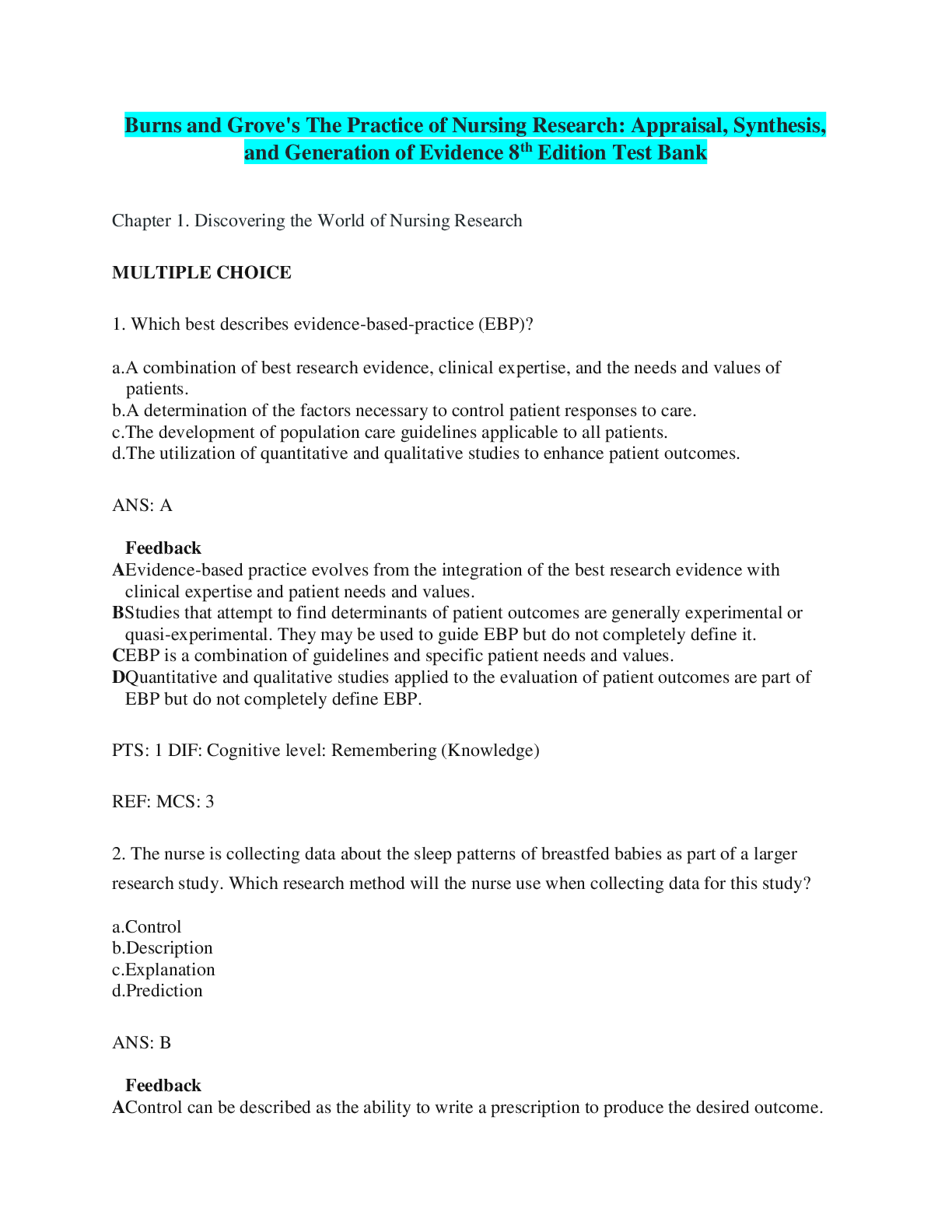
Reviews( 0 )
Document information
Connected school, study & course
About the document
Uploaded On
Jul 08, 2021
Number of pages
408
Written in
Additional information
This document has been written for:
Uploaded
Jul 08, 2021
Downloads
0
Views
30


